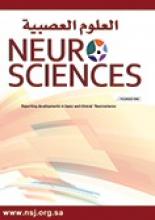Abstract
OBJECTIVE: Certain callosal dimensions, callosal areas, and the optic chiasm (OC) thickness were measured in order to detect any morphometric difference that would imply plastic changes in a selected group of adults.
METHODS: Seventeen early blinds were selected among a group of blind adults after performing interviews. These selected blind subjects, and 23 adults with normal vision of both genders were examined by MRI. The study was conducted in Mersin, Turkey between the years 2004 and 2006.
RESULTS: Only 14 early blind subjects completed the MR imaging procedure. Statistically significant difference between the OC thicknesses of 2 groups was found whereas no statistically significant difference was detected for the callosal dimensions.
CONCLUSION: The difference in the OC dimensions of the 2 groups may be explained by the disuse atrophy. It has been known that if a cortical area of any sense is deprived of stimulus within the critical period, then it may take on another cortical activity. The reasons for the unaffected dimensions of the corpus callosum (CC) in this study may be either the relatively small percentage of the fibers related to vision within the total CC, such as auditory function, of the “normally” visual cortex.
- Copyright: © Neurosciences
Neurosciences is an Open Access journal and articles published are distributed under the terms of the Creative Commons Attribution-NonCommercial License (CC BY-NC). Readers may copy, distribute, and display the work for non-commercial purposes with the proper citation of the original work.






